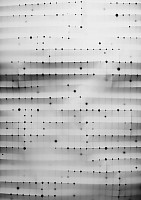BIOGRAPHY

Christiane Feser creates three-dimensional photographic based work. They are photographs of complex assemblages of repeated forms and shadows with actual elements from the assemblage projecting three-dimensionally from the surface of the photograph. Feser flattens a sculptural object through the act of photography and then reconstitutes that dimension in a new way by turning the photograph into a relief sculpture. The works challenge our perception of dimension and perspective as well as our assumptions about what a photograph is. They also introduce a tension between the past and present: the original photograph is of a thing that has existed, but it has been transformed into a new object that now exists. And in this new form, the constant change of light and shadow across the relief surface will continue to keep the work in the present moment. The works are therefore about both photography and sculpture. They are simultaneously images and objects that play with flatness and depth, and engage with the histories of the photograph as a physical thing in space.
The German word Felder has two meanings, it may refer to an agricultural field or field of color, or it may refer to a part of a grid. Each work in this series starts with a drawing of a grid that has been distorted from a flat plane into a sort of topography with dots or spheres of different sizes along the lines. What at first seems to be perspectival, is quickly revealed as something that does not follow the rules of perspective: various parts go in and out of focus, and the dots vary in size as if closer or further away from the camera lens. Feser further confounds the rules of optics by introducing non-photographic, lacquer semicircular spheres protruding from holes in the paper’s surface.
With Loops, Feser has created a series of works based on photographs of strips of paper arranged and lit to emphasize nuances of light and shadow and pattern, and sometimes color. She cuts into the photograph to make parts of the photograph strips of paper again. What seems to have depth is sometimes flat and what seems flat sometimes has dimension.
The works in the series Gitter (Grid) and Nullpunkte (Zero points) and Untitled are photographs of assemblages of sewing pins and their shadows with actual pins that hold the photograph against the backing board. They are a bit like drawing, line based, using shadows instead of pencil or ink, and allude to the origin of the word photograph which was derived from the Greek words photos (light) and graphein (to draw). The work is always evolving because the shadows created by the actual pins on the photograph change significantly depending upon the play of light across the surface. With each series, Feser follows a different method of assemblage of pins and shadows before making the photograph. In the Gitter series, Feser tries to draw a grid from the placement of the pin at the end of the previous pin’s shadow. In Nullpunkte, Feser follows the same rule for placing the pins but, instead of trying to create a grid, she allows the composition to evolve without a preconceived compositional structure. In Untitled, she projects an image of a grid on top of the arrangement of pins.
Feser was born in Würzburg, Germany in 1977 and studied photography at the Offenbach University of Art and Design. She had a solo exhibition at Opelvillen, Rüsselsehim, Germany in 2019 and was included in the exhibition Cut! Paper Play in Contemporary Photography at The J. Paul Getty Museum, Los Angeles, CA in 2018. Other museum exhibitions include the Solomon R. Guggenheim Museum, New York; Centro di Cultura Contemporanea Strozzina, Firenze, Italy; the Mönchehaus Museum, Goslar, Germany; Frankfurter Kunstverein and the Museum for Konkrete Kunst, Ingolstadt, Germany. Her work is in the public collections of Brown University, DZ Bank Art Collection, J. Paul Getty Museum, Solomon R. Guggenheim Museum, Foundation Juan March, Fotografische Sammlung Schloss Kummerow, Minneapolis Institute of the Arts, Mönchehaus Museum, Zentrum für Kunst und Medien.
